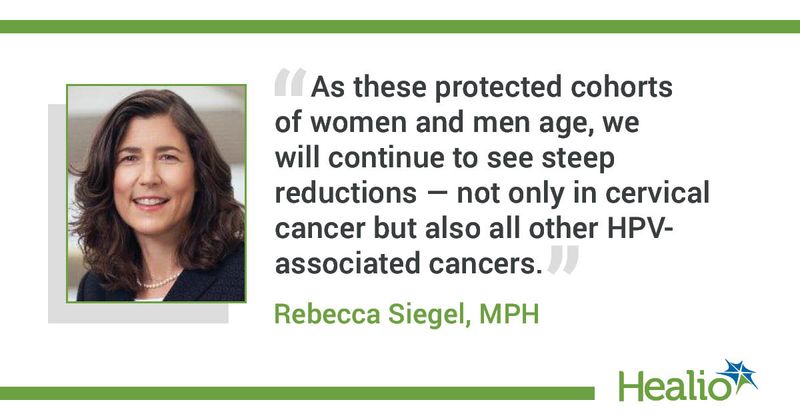Cancer mortality declines 33% in past 30 years; prostate cancer cases on the rise
Cancer mortality in the United States has declined by 33% since 1991, according to an American Cancer Society report released today.
This translates to an estimated 3.8 million fewer cancer deaths during that period, authors of the annual report concluded.

“It was particularly exciting to see that the decline in cancer mortality continued in 2020 because the death [rate] increased for almost every other leading cause of death because of the COVID-19 pandemic,” Rebecca Siegel, MPH, senior scientific director of surveillance research at American Cancer Society, told Healio. “[The decline in cancer mortality occurred] largely because of reductions in smoking, but also because of early detection for some cancers and better treatment.”
The report — published in CA: A Cancer Journal for Clinicians — revealed two surprising trends related to individual malignancies.
The authors observed a sharp drop in cervical cancer incidence among young adult women since 2012.
However, they reported increased prostate cancer mortality, which coincided with higher rates of diagnosis of advanced disease. This finding prompted ACS officials to launch a new initiative aimed to reduce prostate cancer mortality and disparities.
Cervical cancer incidence declines
The report showed a 65% decline in cervical cancer incidence among women aged 20 to 24 years between 2012 and 2019.
This cohort was the first eligible to receive the HPV vaccine following its approval in 2006.
The more than halving of cervical cancer incidence may be the first of many declines for HPV-related cancers, Siegel said.
“This magnitude of change is not possible in the natural course of disease and could only be the result of medical intervention, such as the vaccine,” Siegel told Healio. “As these protected cohorts of women and men age, we will continue to see steep reductions — not only in cervical cancer, but also all other HPV-associated cancers, like throat, anal, penile and vaginal cancers.”
The cervical cancer trend provides “clear population-level evidence” about the impact vaccination can have on cancer incidence, according to Ahmedin Jemal, DVM, PhD, senior vice president for surveillance and health equity science at American Cancer Society.
“Increased investment in strategies to harness the immune system in cancer prevention is warranted,” Jemal said in a society-issued press release.
Prostate cancer incidence rises
The report also highlighted a 3% annual increase in prostate cancer incidence from 2014 to 2019.
The rising incidence coincided with 4% to 5% annual increases in advanced-stage prostate cancer diagnosis since 2011. The proportion of men diagnosed with distant-stage disease doubled during that period.
The increase is prostate cancer incidence is “very concerning” for multiple reasons, Siegel said.
“First, it comes on the heels of decades of declining trends, including a decrease of 6.5% per year from 2007 to 2014, so it is a reversal in years of progress,” Siegel told Healio. “Second, the increase is currently confined to advanced-stage disease, which has been increasing by 4.5% per year since 2011. ... Third, prostate cancer has one of the largest racial disparities of any cancer, with death rates [among Black men] two to four times higher than those [among] men of every other race or ethnicity.
“Prostate cancer mortality had been decreasing by 3% to 4% per year from 1994 through 2013, but has slowed to 0.6% per year since and will likely reverse course if incidence patterns continue,” she added.
In response to these findings, ACS launched IMPACT: Improving Mortality from Prostate Cancer Together.
The effort will fund new research programs designed to help identify who is most at risk for prostate cancer and identify prevention strategies.
“This groundbreaking initiative will leverage our unique organizational strengths to mobilize resources across advocacy, patient support and research,” Karen Knudsen, MBA, PhD, the cancer society’s CEO, said in the press release. “ACS is committed to utilizing a tripartite strategy to reverse prostate cancer disparities and reduce death rates from prostate cancer in all demographics and disparities for Black men by 2035.”
Other components of IMPACT will expand patient support to ensure access to quality screening and care, as well as public policy efforts intended to address the prostate cancer burden in the US.
Additional trends
The report authors estimated 1.95 million new cancer cases will be diagnosed in the U.S. in 2023, with 609,820 cancer deaths projected for the year.
Among the report’s other findings:
- lung and colorectal cancer are among the three leading causes of cancer death for both men and women;
- approximately 350 people in the U.S. die of lung cancer each day;
- lung cancer among women decreased at half the pace of men (1.1% annually vs. 2.6% annually) from 2015 through 2019;
- breast, uterine corpus, liver and skin cancer incidence rates continued to increase;
- female breast cancer incidence rates increased by approximately 0.5% per year since the mid-2000s; and
- thyroid cancer incidence rates declined by about 2% per year since 2014 following decades of increases, with the reversal attributed to changes in clinical practices.
References:
- American Cancer Society releases latest cancer statistics, launches initiative to address prostate cancer resurgence and disparities (press release). Published Jan. 12, 2023. Accessed Jan. 12, 2023.
- Siegel RL, et al. CA Cancer J Clin. 2023;doi.10.3322/caac.21763.
For more information:
Rebecca L. Siegel, MPH, can be reached at Surveillance Research, American Cancer Society, 250 Williams St., NW, Atlanta, GA 30303-1002; email: rebecca.siegel@cancer.org.


